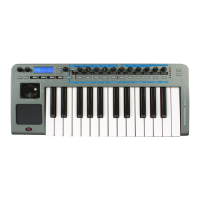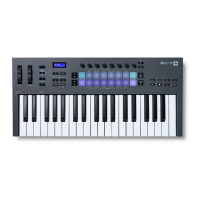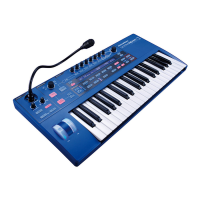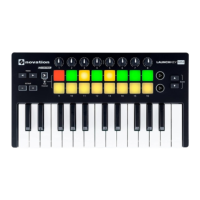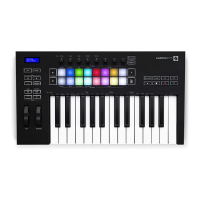The Oscillators And Mixer
The Oscillator is really the heartbeat of the Synthesizer. It generates an
electronic wave (which creates the vibrations). This Waveform is pro-
duced at a controllable musical pitch, initially determined by the note
played on the keyboard or contained in a received MIDI note message.
The initial distinctive tone or timbre of the waveform is actually deter-
mined by the wave’s shape.
Many years ago, pioneers of musical synthesis discovered that just a
few distinctive waves contained many of the most useful harmonics for
musical synthesis. The names of these waves reflect their actual shape
when viewed on an instrument known as an Oscilloscope, and are
known as, Sine waves, Square waves, Sawtooth waves, Triangle
waves and Noise Waves.
Each one has a specific fixed amount of musically related harmonics
(except noise waves) which can be manipulated by further sections of
the Synthesizer.
The diagrams below show how these waveforms look on an
Oscilloscope and illustrate the relative levels of their harmonics.
Remember, it is the relative levels of the various harmonics present in a
waveform which determine the tone of the final sound.
Sine Waves
These have just a single frequency. This waveform produces the purest
sound because it only has this single pitch (frequency).
Triangle Waves
These contain only odd harmonics. The volume of each is the square of
its position in the harmonic series. For example, the 5th harmonic has a
volume of 1/25th of the fundamental.
Sawtooth Waves
These have a rich proportion of harmonics, containing all the harmonics
of the fundamental frequency. The volume of each harmonic is propor-
tional to its position in the harmonic series.
Square Waves
These only have only the odd harmonics present. These are at the same
volume as the odd harmonics in a sawtooth wave.
It will be noticed that the square waveform spends an equal amount of
time in its ‘high’ state and its ‘low’ state. The way in which this defined
is known as the ‘duty cycle’. A square wave always has a duty cycle of
50% which means it is ‘high’ for 50% of the waveform cycle and ‘low’
for the remaining 50% of the waveform cycle.
With the KS Synth, it is possible to adjust the duty cycle of the basic
square waveform to produce a waveform which is more ‘rectangular’ in
shape. These are often known as Pulse waveforms. As the waveform
becomes more and more rectangular, more even harmonics are intro-
duced and the waveform changes its character, becoming more ‘nasal’
sounding.
The width of the pulse waveform (often known as ‘Pulse Width’) can be
altered dynamically by a modulator which results in the harmonic con-
tent of the waveform constantly changing. This can result in the wave-
form having a very ‘fat’ quality when the pulse width is altered at a mod-
erate speed.
When listening to a pulse wave, it does not make any difference to the
perceived sound whether the duty cycle is 40% or 60% since the wave-
form has just been inverted and the harmonic content between the two
is exactly the same.
SYNTHESIS TUTORIAL
The Oscillators And Mixer
• 31 •

